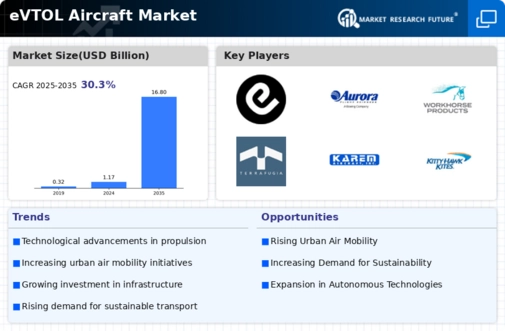Market Trends
Key Emerging Trends in the eVTOL Aircraft Market
The electric vertical takeoff and landing (eVTOL) aircraft market is experiencing significant growth and evolving trends driven by advancements in electric propulsion technology, urban air mobility (UAM) initiatives, and the demand for sustainable transportation solutions. One prominent trend in this market is the increasing interest and investment in eVTOL aircraft as a promising mode of urban transportation. With the rise of megacities and urbanization trends, there is growing congestion on roads and challenges in traditional transportation infrastructure, leading to a need for alternative modes of transportation. eVTOL aircraft, with their ability to take off and land vertically and operate in densely populated urban areas, offer a potential solution to address these challenges by providing fast, efficient, and environmentally friendly aerial mobility options for passengers and cargo transport.
Moreover, technological advancements in electric propulsion systems, battery technology, and autonomous flight control systems are driving innovation and enabling the development of next-generation eVTOL aircraft. Electric motors offer several advantages over traditional combustion engines, including lower emissions, reduced noise levels, and lower operating costs, making them well-suited for urban air mobility applications. Additionally, advancements in battery energy density, charging infrastructure, and electric powertrain efficiency are extending the range and endurance of eVTOL aircraft, enhancing their practicality and viability for commercial operations. Furthermore, the integration of autonomous flight technologies, including artificial intelligence, sense-and-avoid systems, and advanced navigation algorithms, is enabling eVTOL aircraft to operate safely and efficiently in complex urban airspace environments.
Furthermore, the eVTOL aircraft market is witnessing a proliferation of industry collaborations, partnerships, and investments aimed at accelerating the development and commercialization of eVTOL technology. Aerospace manufacturers, technology startups, ride-hailing companies, and government agencies are collaborating to bring eVTOL aircraft to market and establish the necessary infrastructure and regulatory frameworks to support urban air mobility operations. Strategic partnerships between aircraft manufacturers and infrastructure providers, such as vertiports and charging stations, are essential for scaling up eVTOL operations and creating a seamless aerial transportation network in urban areas. Additionally, investment from venture capital firms, corporate investors, and government funding programs is fueling research and development efforts and driving innovation in eVTOL technology.
Moreover, the COVID-19 pandemic has accelerated the adoption of eVTOL aircraft and highlighted the importance of resilient and flexible transportation solutions. The pandemic has led to changes in travel patterns, increased demand for contactless transportation options, and heightened awareness of health and safety concerns associated with crowded public transportation. eVTOL aircraft offer a compelling solution for addressing these challenges by providing on-demand, point-to-point aerial transportation with reduced passenger density and minimal physical contact. As cities and communities look to build back better and recover from the pandemic, there is growing interest in eVTOL aircraft as a transformative solution for sustainable urban mobility and economic recovery.
However, despite the opportunities and advancements in the eVTOL aircraft market, several challenges remain, including regulatory hurdles, infrastructure limitations, and public acceptance concerns. Regulatory agencies and aviation authorities are working to establish certification standards, airspace regulations, and safety guidelines for eVTOL operations to ensure the safe integration of these aircraft into existing airspace infrastructure. Additionally, building the necessary infrastructure, including vertiports, charging stations, and air traffic management systems, poses logistical and financial challenges for urban air mobility deployment. Moreover, addressing public perception and acceptance issues, such as noise pollution, privacy concerns, and community impact, will be crucial for gaining public support and trust in eVTOL technology and realizing its full potential for transforming urban transportation.









Leave a Comment